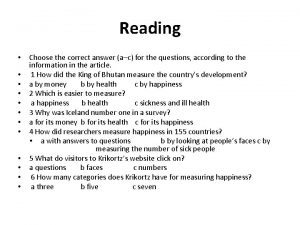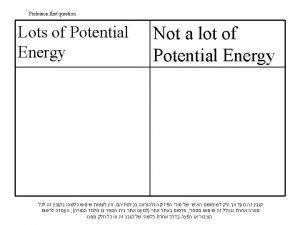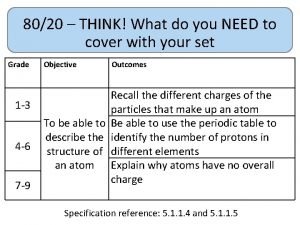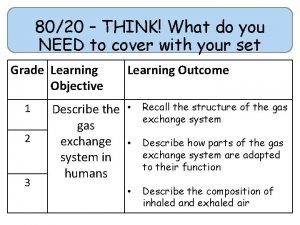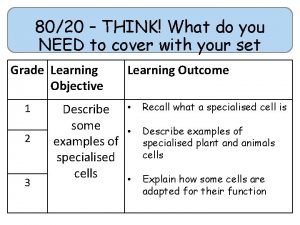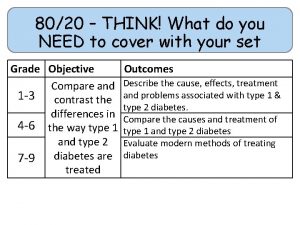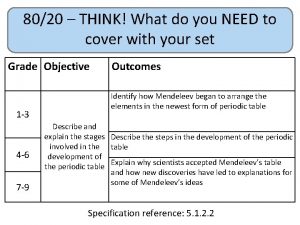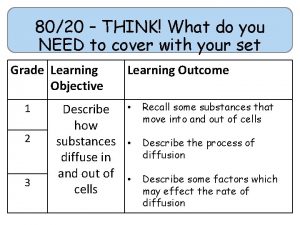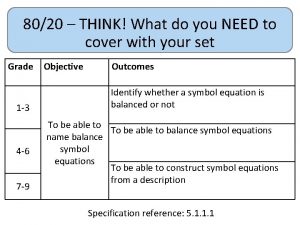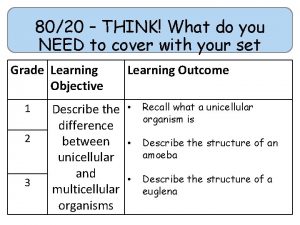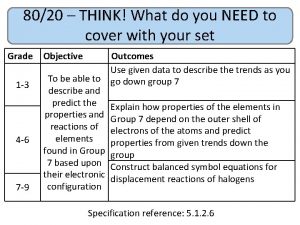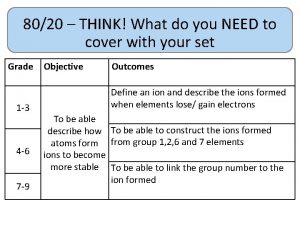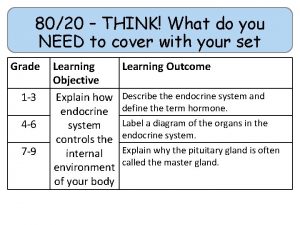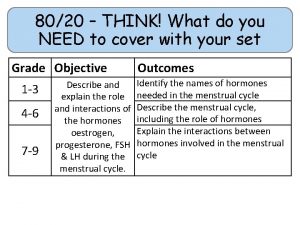8020 THINK What do you NEED to cover


















- Slides: 18

80/20 – THINK! What do you NEED to cover with your set Grade Learning Objective 1 2 3 Describe the process of breathing Learning Outcome • Recall the process of inhaling and exhaling • Describe how a bell jar can be used to model what happens during breathing • Explain how to measure lung volume.

Breathing Do now activity: Try to label as many parts of the respiratory system as you can!!

Progress indicators GOOD PROGRESS: • Recall the process of inhaling and exhaling • Describe how a bell jar can be used to model what happens during breathing OUTSTANDING PROGRESS: • Explain how to measure lung volume.

How do you breathe? Just sit quietly for a few minutes and think about what is happening when you breathe in and out. • What does it feel like? • What do you notice happening to your chest? As you breathe in you should feel your chest tighten as muscles contract. You should observe your chest rising and falling as you breathe in and out, this movement is helped by your intercostal muscles moving your ribcage.

Breathing in and breathing out Task: Watch the video and complete the following sentences: 1. During inhalation (breathing in), the intercostal muscles ____, pulling the ribcage upwards and _______. The diaphragm also contracts, which causes it to lie _____. Overall, the volume of the thorax ____ and the pressure ____, this draws air into the lungs. 2. During exhalation (breathing out), the intercostal muscles _______, pulling the ribcage inwards and ______. The diaphragm _______, returning to a dome shape. Overall, the volume of the thorax _____ and the pressure increases, this forces air ____ of the lungs. https: //www. youtube. com/watch? v=yl. Ekn. Rf 0 j. LU

Self-assessment: 1. During inhalation (breathing in), the intercostal muscles contract, pulling the ribcage upwards and outwards. The diaphragm also contracts, which causes it to lie flat. Overall, the volume of the thorax increases and the pressure decreases, this draws air into the lungs. 2. During exhalation (breathing out), the intercostal muscles relax, pulling the ribcage inwards and downwards. The diaphragm relaxes, returning to a dome shape. Overall, the volume of the thorax decreases, and the pressure increases, this forces air out of the lungs.

Task: Complete the cartoon strip to demonstrate what happens to the lungs during inhalation and exhalation


The Bell Jar We can use a bell jar to demonstrate the process of breathing in and out. • The jar represents your chest • The balloons are your lungs • The rubber sheet underneath is your diaphragm

Teacher Demo ~ Bell Jar Observe what happens when the rubber sheet is pulled downwards. What is happening to the balloons? Explain why this happens in terms of volume and pressure. Observe what happens when the rubber sheet is pushed upwards. What is happening to the balloons? Explain why this happens in terms of volume and pressure.

Self-assessment: As the rubber sheet is pulled downwards, the volume of the gas increases, this decreases the pressure. Air is then drawn into the bell jar, filling the balloons. As the rubber sheet is pushed upwards, the volume of the gas decreases, this increases the pressure. Air is then forced out of the bell jar, which is why the balloons deflate.

How do we measure lung volume? You can measure your lung volume using the apparatus shown here. By breathing out fully into the plastic tube you can measure your total lung volume. As the air flows into the plastic bottle it will displace water, the total volume of water pushed out of the bottle is equal to how much air your lungs can hold!! Plastic bottle (full of water) Plastic tube Tank with water

Plenary ~ Word search Find the following words in the word search: • • • Alveoli Breathing Oxygen Trachea Bronchus Bronchiole Exhalation Inhalation Lungs

Resources

Inhalation The _____ muscle between your rib's contracts, this pulls your ribcage _____ & ______ The _____ contracts, this causes it to lie flat. The _______ of the thorax (inside your chest) has now increased. The pressure inside the chest _____. Air is drawn into the lungs down a pressure gradient. Exhalation The _____ muscle between your rib’s _______, this pulls your ribcage _____ & ______ The _____ relaxes, this causes it to return to it’s dome shape. The _______ of the thorax (inside your chest) has now decreased. The pressure inside the chest _____. Air is forced out of the lungs down a pressure gradient.

Inhalation Exhalation


 Iso 8020
Iso 8020 Mukesh ambani signature
Mukesh ambani signature If you think you can you can poem
If you think you can you can poem Six cardinal fields of gaze
Six cardinal fields of gaze Intermittent exotropia
Intermittent exotropia Maddox rod test procedure
Maddox rod test procedure I wish you all the strength you need
I wish you all the strength you need Punctuating split speech
Punctuating split speech Robin and jay poem
Robin and jay poem Think family ni
Think family ni So you think you can argue
So you think you can argue Choose the correct answers a-c.
Choose the correct answers a-c. So you think you can argue
So you think you can argue You know minecraft
You know minecraft What do you think of when you hear the word family
What do you think of when you hear the word family You have more potential than you think
You have more potential than you think What makes plants grow
What makes plants grow What do you think of when you hear
What do you think of when you hear You can argue
You can argue











